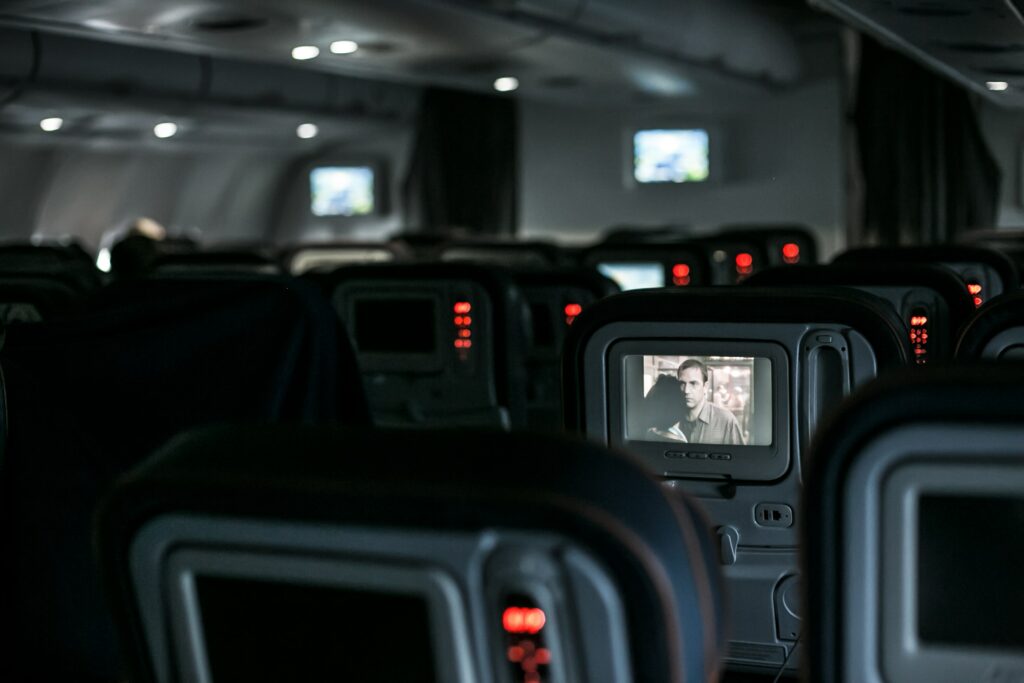Airlines experience a myriad of potential problems, from flight delays and cancellations to workforce shortages and security concerns. And to combat these, airlines may rely on several turnkey solutions — end-to-end systems that solve a specific problem and are ready to implement.
One area of the cabin that has massive upward application for turnkey solutions is In-Flight Entertainment and Connectivity (IFEC).
‘The IFEC zone [at AIX] is fantastic, satellite communication is very ‘trendy,’ and it is highly represented here which has been a great learning and networking opportunity.’
Modifications Engineer
Aviation MRO
What are turnkey solutions?
Turnkey solutions are everywhere. They offer the opportunity to integrate third party supplier products and ready-to-go solutions to carriers that, in their best applications, can reduce cost and risk.
By reducing the need for coordination among multiple suppliers, turnkey solutions offer fully packaged products that cut down on implementation time significantly.
The impact of turnkey software and hardware for airlines’ IFEC offerings could be the key to a quicker fleet overhaul while still offering entertainment and connectivity to passengers.
In-Flight Entertainment Turnkey Solutions
It is important to win the trust and repeat business of customers by giving them a great flying experience. And one way to ensure the satisfaction of passengers is by providing them with in-flight entertainment.
Air travel recovery globally is regrowing, if uneven, for now. In the USA, air traffic has already exceeded its 2019 level in 2022. However, international air traffic in the Asia Pacific region is just below two-thirds of its 2019 level. In June 2023, European flight traffic reached 92%.
And in-flight entertainment and connectivity is a key component for airlines, as it may define a passenger’s overall flight experience. It can help reduce the psychological and physical stress within the cabin environment. It is even an important selection criterion for passengers when booking travel with a particular carrier.
Without investing in IFEC systems, airlines may be losing the interest of two in five fliers. When passengers have a good time during their flight, it may lead them to book the same airline on their next trip. And IFEC systems can also offer branding solutions for airlines to introduce other products or services onboard or as an advertising space.
This is where IFEC is vital. Ever since the beginning of air travel, IFEC has always been at the heart of the passenger experience. Passengers are coming to expect that they will be able to do everything they can do at home while on a plane. With Integrated IFEC systems, passengers can work, watch a movie, play games, or simply surf the internet while onboard.
‘The In-Flight Entertainment and Connectivity Market size was valued at USD 6,144.54 Million in 2022 and is projected to reach USD 11,502.56 Million by 2030, growing at a CAGR of 8.29% from 2023 to 2030.’
Crew and Customer Benefits
IFEC holds massive potential for understanding the behaviour of, and tailoring services for, passengers. With these systems, carriers can apply advanced analytic capabilities and adopt insight-driven and behavior-based advertising practices.
This, in turn, can increase the engagement of passengers resulting in ancillary revenue generation. It may also help crew to deploy food and beverages faster, with inventory and promotion management systems. Flymingo IFEC hardware platform by Moment Tech, for example, not only processes galley inventory but also checks seatbelts and tray table positions and identifies free space in overhead bins.
Another innovation is AirFi’s portable IFE solution, which helps passengers to easily purchase goods and services and also relieves the crew from unnecessary administrative tasks.
When AIX sat down with the founder and CEO of AirFi, Job Heimerikx, and he emphasised the importance of an accessible “Mall in the Sky”.
“Third party partnerships are becoming more commonplace in the airline commercial ecosystem and the Mall in the Sky enables easier third-party integration thanks to our open platform.
By working with their preferred partners (or by choosing some from our partner portfolio), airlines can offer a richer inflight shopping and entertainment experience.”
Connectivity also supports cabin and flight deck services. IFC can be leveraged to boost work efficiency through deploying surveys and analysing flight log information. IFC also supports inventory information, can allow for updating passengers on connecting flights, and record maintenance issues or unruly passenger behaviour.
It has even been shown that flight attendants can deal with requests more efficiently when sent via text or voice messages via these onboard systems.
“There have been some really interesting new products in the IFEC Zone at AIX, and it’s been great to test them out.”
Supervisor, Interior Group, Engineering Department
JAL EngineeringPassenger Benefits
In-flight entertainment and connectivity solutions enhance the flying experience of passengers. For passengers, it is extremely important to have easy Wi-Fi access. One study showed that 66% of travellers decide which flight to book based on in-flight Wi-Fi availability and 22% pay more to board a Wi-Fi equipped aircraft.
In-flight entertainment systems are expected to provide high navigation speeds, high-resolution streaming, and protected and secured wireless networks. On long-haul flights, IFEC, with a wide range of entertainment content, can contribute to mitigating boredom or anxiety for travellers. IFE systems contribute to the satisfaction of passengers with airline services, and in turn could positively impact airline revenues.
And seatback technology still appears to be a market leader despite the rise in bring-your-own-device (BYOD) solutions onboard. In fact, Aurélien Timbre, Sales Development at CELSO, thinks that the future will see more seats installed with IFEC systems, and this will continue to be a market driver. He added that “seating suppliers that offer innovations that provide more comfort and luxury to passengers are set to be in poll position.”
Another system deployment is the ability to control cabin interior lighting, which is also beneficial for passengers. During an interview with AIX, Pierre Michard, Sales & Programmes Director at STG Aerospace, said that lighting solutions can enhance passenger ambience and the in-flight experience.
Electrochromic windows, for example, allow passengers to adjust the level of tint to reduce glare and heat during flights. Cabin interior lighting systems give the impression of space and freedom, and this is crucial for passengers.
“Airlines always want to do more with the cabin space they have. The combination of photoluminescent and LED lighting can help with space use by providing guidance and subtle indications of cabin usage. This ranges from returning space to passengers for a more premium offering or adding extra rows of economy class seats.”
Custom-built or turnkey solutions?
Turnkey solutions are ready to operate, whereas custom-built solutions may take time to be implemented as they need to be designed following the client’s preferences and requirements.
Airlines may opt for turnkey solutions as these can be implemented more quickly than building solutions from scratch. Turnkey solutions may also be cheaper as they offer a fixed cost compared to custom-built solutions, where expenses may depend on the structure’s specific needs.
Austen Miller, a product innovation expert, says that turnkey solutions are cheaper because design costs can be capped. This helps clients anticipate their budget better. Plus, turnkey solutions already adhere to strict aviation standards as they are developed by experts, minimising the need to invest in developing the same level of knowledge internally.
Some airlines have even partnered with IFEC providers to create custom-built solutions.
Panasonic Avionics and Saudi Arabian Airlines (SAUDIA) signed an agreement for the installation of the Astrova seat-end solution on the airline’s 30 aircraft, which will offer a fully immersive experience for SAUDIA’s passengers.
The IFE seat-backsolution will give guests access to 4K OLED screens, 100 W of direct current power via USB-C, and programmable LED lighting. This collaboration agreement should meet the changing market requirements and satisfy the constantly evolving expectations of passengers.
Meanwhile, the partnership between Japan Airlines (JAL) and Intelsat brings the installation of Intelsat’s 2Ku systems, enabling a free in-flight internet experience. This makes J-AIR the first regional aircraft offering IFC services in Japan.
Astronics’ IFEC system was also selected to be a part of AMAC Aerospace. Its IFEC system comes with ultra-high-definition (4K) touch screens, 4K audio/video sources, passenger control units, and digital rights-managed (DRM) entertainment content. This should provide passengers with VIP entertainment and connectivity experiences.
Turnkey solutions may be a quick fix for aviation, but they may lack scalability and the customisation businesses are looking for. Since they are not customised, businesses may need to allocate extra funds to make up for additional custom features.
The choice will, ultimately, reflect a business’ budget, goals, scaling plans, and other factors. Both are beneficial to the industry, but businesses may need to assess if the problem they are facing is something that needs to be fixed right away or if following a longer timeline is feasible.
The Future of IFEC
Turnkey solutions, like investing in in-flight entertainment and connectivity, can certainly continue to help the industry recover and leverage resurgent passenger numbers.
And IFEC is beneficial to both airline management and a carrier’s passengers. It helps make the work of the airline crew easier. It also excites passengers and improves satisfaction. And, finally, if passengers are satisfied, this correlates to loyalty to the airline, which potentially means more tickets sold and revenue increases.
The IFEC market is continually growing because of the rising demand from passengers to be connected even while they are onboard. So expect more screens, streaming capabilities, gaming, personalised shopping opportunities, and light, smell, and sound manipulation as in-flight technology and capabilities expand in the coming years.



